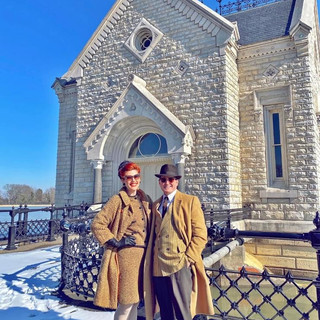Crescent Hill Reservoir
Several people have asked about the beautiful water company reservoir in Louisville (Crescent Hill Reservoir & Gatehouse), where several of our photos in our Sunday post were taken.
For those ever thinking of visiting the Louisville area, and you want some ideas on where and when to visit, let us know! We’re not quite experts, but we can sure give you some great pointers. There are so many great things to see and do in the Louisville and southern Indiana area that you can make an entire week-long visit here and only scratch the surface!
I thought I would give you a little more info on the reservoir. It’s truly fascinating and beautiful to visit in any season, as highlighted by our photos. We try to visit at least of couple of times each year. It is a great place for a beautiful walk and some pretty amazing photos.
Now, more about the reservoir and the beautiful historic gatehouse.
The fully restored historic Crescent Hill Gatehouse reopened to the public on May 13, 2015. This was the first large-scale restoration of the gatehouse, which was designated a Kentucky Historic Site in 2010.
In 1860 the first 512 customers, mostly businesses, who received running water got straight river water, minus only the mud that had settled out. The original Reservoir was where the Louisville Veteran's Medical Center is today. Old annual reports say when you got a cup of water from Louisville Water in 1860, it sometimes had some leftover mud in it! We’ve improved a lot since then. As demand increased, the company needed a new reservoir. At that time Crescent Hill was farms and large private estates. There was lots of open land available and the new site would be 33-feet higher than the old one. More importantly, the new reservoir would a have 110-million gallon capacity, which was ten times the capacity of the first.
Water had to travel from the Ohio River to the new reservoir. Workers cut through the rock and dug a deep ditch for a large, 30-inch diameter main. When a road was eventually added, it was called “Pipe Line Lane.” That road is now Zorn Avenue after Sebastain Zorn, who served as president of Louisville Water Company.
Chief Engineer Charles Hermany designed the Reservoir. He built the facility with functionality and design in mind. Surveys were taken for the Reservoir in 1874. Work began on the site in 1877 and when it opened in 1879, the Reservoir, 110-million-gallons in both sides, held at least a two-week supply of water. Today, it holds not quite enough for one day. The Gatehouse contained valves that controlled the rush of water in and out of the Reservoir
Upon its completion, the Crescent Hill Reservoir became an instant tourist attraction. Within the first few years of operation, amenities were built to handle the many visitors who came by train, horse and buggy, and walked to visit the grounds. The company employed “gate keepers” to open gates at now Brownsboro Road and Frankfort Avenue and planted trees, built a lake and even installed hitching posts. Some visitors came by train to visit the grounds. There were even rules for how guests should conduct themselves. The men who helped oversee the grounds and the company operations most likely lived on-site in small houses the water company built. The water company also built a Visitor’s Shelter to accommodate guests -- it’s the “L-shaped” building that sits across from the Mary T. Meagher Natatorium today. Complete in 1885, the building included water closets and bathrooms and a common area. Today, the building is nearly identical to what it looked like in 1885. The roof suffered significant damage in the 1974 tornado.
Today, the reservoir is still part of Louisville Water’s Crescent Hill operations although the valves in the gatehouse are not used. Employees control the flow of water in and out of the reservoir at the treatment plant.
Recent Posts
See AllSpring & Summer Tea Events – Tickets on Sale Now! Tickets for our April–July events at The Old Capitol Tea Room are now available!...








































Comments